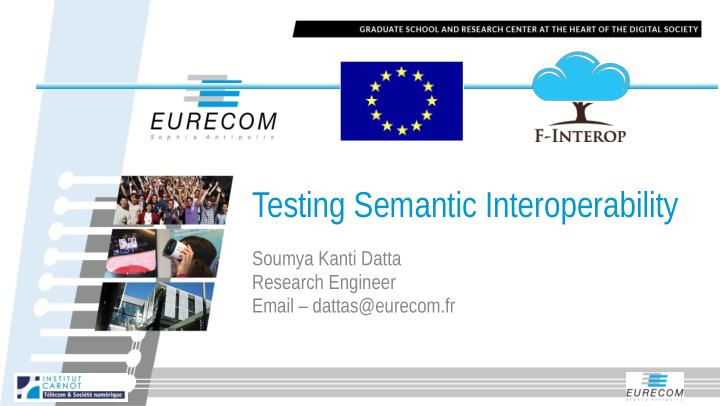



Testing Semantic Interoperability Soumya Kanti Datta Research Engineer Email – dattas@eurecom.fr
22/03/2018 T esting Semantic Inteoperability 2
Roadmap • Introduction • Testing Semantic Interop • Survey • Conclusion 22/03/2018 T esting Semantic Inteoperability 3
Introduction • Interoperability - key to achieve the full potential of the IoT market. • Due to the highly dynamic nature of the IoT, a strong need of interoperability at data level has emerged so that it becomes easier to combine/aggregate, process, manage and store the data/event coming from heterogeneous data sources. • Semantic interoperability is a way to address the problem. 22/03/2018 T esting Semantic Inteoperability 4
Introduction • We need tests that validate the semantic compliance and interoperability among IoT systems. – To boost the acceptance and adoption of the semantic technologies by the IoT market. • Testing semantic interoperability is identified as a gap in the current IoT research and industrial initiatives. • SemTest, an Industrial Extension of EU H2020 F-Interop project addresses this part. 22/03/2018 T esting Semantic Inteoperability 5
Two Types of Testing • Conformance testing – To test if a piece of semantic data conform to a reference ontology • Interoperability testing – To check if two parties understand correctly the exchanged semantic data 22/03/2018 T esting Semantic Inteoperability 6
Requirements – Conformance Test • Lexical check • Syntactic check – Untyped of resources and literals – Ill-formed URIs – Problematic prefix and namespaces – Unknown classes and properties • Semantic checks – Cardinality inconsistency – Problematic relationship or inheritance 22/03/2018 T esting Semantic Inteoperability 7
Conformance Test Scenario 22/03/2018 T esting Semantic Inteoperability 8
Requirements – Semantic Interop Test • Communication level check • Lexical/format level check • Data processing check 22/03/2018 T esting Semantic Inteoperability 9
Semantic Interop Testing Scenario Objective Test the semantic processing results from two systems Pre-test SUT1 and SUT2 both have semantic query processing condition capability Transmitted semantic data (D1) have been validated its conformance SPARQL query Q1 is prepared T est Sequence Step Description 1 SUT 1 sends its semantic data D1 annotated to SUT 2 2 SUT 2 executes query Q1 upon the semantic data received D1, for example, to execute a query to get the resources that has X property(ies). SUT 2 gets result of the execution R1 3 SUT 2 sends the result R1 to SUT 1. 4 SUT 2 sends the query Q1 to SUT 1 5 SUT 1 executes the received query Q1 upon D1 and gets the result R1’ 6 SUT 1 compares R1 and R1’. R1 and R1’ are equivalent 22/03/2018 T esting Semantic Inteoperability 10
Semantic Interop Testing and oneM2M AE – Application Entity CSE – Common Service Entity 22/03/2018 T esting Semantic Inteoperability 11
Semantic Interoperability Between Systems Scenario Architecture 22/03/2018 T esting Semantic Inteoperability 12
Interoperability at Data Level Objective Test the semantic data for checking if they share the same vocabulary Pre-test Transmitted semantic data (D1 and D2) have been condition validated its conformance T est Sequence Step Description 1 SUT 1 submits semantic data D1 to a third-party module (T ester) 2 T ester retrieves the vocabulary of D1: V1 3 SUT 2 submits semantic data D2 to T ester 4 T ester retrieves the vocabulary of D2: V2 5 T ester compare V1 and V2. They are identical to be interoperable 100% 6 The result from the previous step is communicated to SUT 1 and SUT 2 22/03/2018 T esting Semantic Inteoperability 13
Data Level Interoperability Scenario Architecture 22/03/2018 T esting Semantic Inteoperability 14
Survey • Please complete our survey on Testing Semantic Interoperability (takes ~5 minutes) – https://goo.gl/forms/h3wgsyOpztxA3lSG2 22/03/2018 T esting Semantic Inteoperability 15
Conclusion • Testing for semantic interoperability is necessary in IoT. • We propose two types of tests. • Test scenarios are proposed to implement the semantic conformance and interoperability tests. • Future work - we will implement the tests within the F-interop platform and report our results. 22/03/2018 T esting Semantic Inteoperability 16
Acknowledgement • SemTest is an Industrial Extension of F-Interop EU H2020 Project. F-Interop has received funding from the European Union’s Horizon 2020 research and innovation programme under grant agreement No 687884. • SemTest is a joint project between Easy Global Market and EURECOM. 22/03/2018 T esting Semantic Inteoperability 17
Thank You • Email: dattas@eurecom.fr • Website: http://iot.eurecom.fr/ 22/03/2018 T esting Semantic Inteoperability 18
Recommend
More recommend